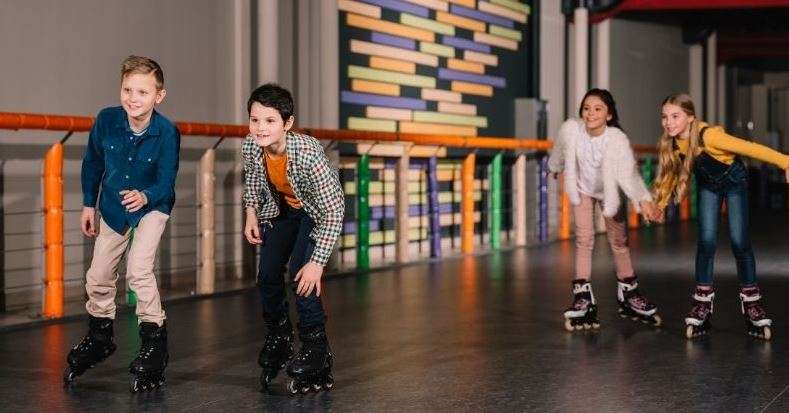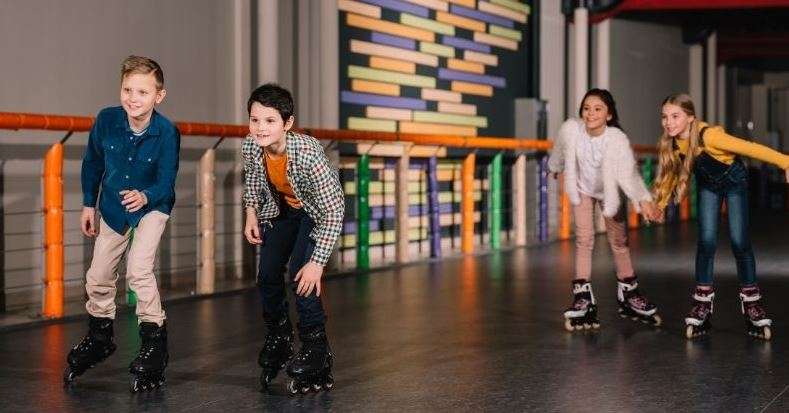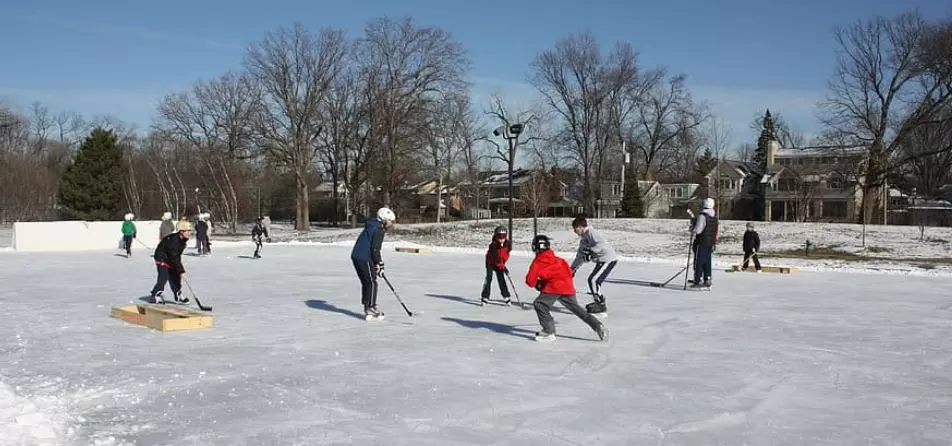Last updated on November 7th, 2022 at 10:16 pm
If you are reading this post. it simply means you want to learn about how roller skating rinks cold.
The skating rinks are structures or indoor buildings consisting of a flat smooth, horizontal surface manufactured and maintained for the sole aim of ice skating or roller skating.
The dry surface of the rinks enhances or accommodates the rubber wheels of roller skates. Similar, ice skating rinks are smooth and of ice, which athletes (skaters) perform on, but the skaters are required to have special wear whenever any event occurs on the rinks.
Nevertheless, this post will help you understand some content, such as; why the ice rink is so cold, how cold most ice rinks are, and what I should wear to ice skating indoors.
What should you not wear for ice skating, what is the temperature at Beijing Olympics, how cold is it in China for the Olympics, how thick is the Olympic ice, and more?

Without much ado, let’s get to it quickly!
Ice Skating Rink Temperature Celsius?
The temperature of the skating rink varies as it is between -4 to 4 degrees Celsius, and the most common air temperature seems to be between 10 to 15 degrees Celsius.
What Temperature Is Good For Ice Skating?
The temperature for ice skating ranges from 24 to 29 degrees Fahrenheit for soft skating activities, while 17 to 23 degrees Fahrenheit is also ideal for hard skating.
Importantly, hard ice allows for faster and smoother skating. In contrast, softer ice is slower with a highly choppy and snowy surface, so it is preferred for figure skating because it enhances soft landing.
How Cold Is The Ice Rink At The Olympics?
The surface of the ice rink at the Olympics is between the ranges of temperatures of 15.8 to 19 degrees Fahrenheit. Similarly, in standard measurement, it is -3.5 to 2.2 degree Celsius.
Why Is The Ice Rink So Cold?
The ice rink is cold because of the chilled concrete slab of -4 degrees Celsius, frozen-thin layers of 0 degree Celsius, and an air temperature of about 12.8 degrees Celsius below the standard room temperature of 20 degrees Celsius.
Let’s discover the structure of the ice in the rink!
Contemporarily, the ice skating rink features some layers, as the topmost layer is the chilled concrete slab, which is where the skating rests.
However, the insulation system is below the heated concrete sand, gravel base, and groundwater drain. Notably, there are several metal pipes inside the concrete slab.
In the same vein, ice skating rinks also include a refrigeration system that functions as a domestic or commercial refrigerator. However, this device keeps the ice rink cold.
How Cold Are Most Ice Rinks?
Rinks are very cold, although most ice rinks have an ice temperature of about 24 – 25 degrees Fahrenheit. Nevertheless, this temperature varies significantly depending on the managerial standards and location of the rinks.
What Should I Wear To Ice Skating Indoors?
As a skater, you would think that when it comes to what you could wear to an indoor ice skating rink, all you need is to go to a friend and rent some skates, and you are off on that.
Unfortunately, without appropriate gear, you would Perphs get cold, uncomfortable, and possibly unsafe.
Though you need to do much planning to enjoy indoor ice skating, some people would say, “I have skates,” but having skates is not enough! Proper clothing will enhance and keep you warm and cozy throughout your fun time in the rinks.
With that in mind and at heart, let’s dive into what you need to wear when you intend to ice skate indoors.
Here you have the list!
· Pants or Leggings.
Since ice skating is a winter event, hitting the ice with pants is, to an extent, an etiquette.
However, you should never wear shorts or dresses when you go on indoor ice skating. Although some people do that, it is wrong!
In the same vein, men could wear sweatpants that shouldn’t be too baggy or long, while women should wear leggings or cozy pants.
· Knees Pads
Invariably, some people reject knee or elbow pads as they think it is for roller skating and skateboarding. Nevertheless, the knee or elbow pads can also be worn optionally and not necessarily.
1. Ice Skates?
Undoubtedly, the most vital equipment to wear to an indoor ice skating rink, you could rent skates if you don’t have one.
Notwithstanding, be sure of the type of skates you have and ensure they are correctly fitted to avoid blisters and possible ankle rubbing.
2. Padded Shots?
Padded shorts are vital for beginners since they support the thigh, tailbone, and rear in the incidence of falls on the ice rinks. But it is optional for professionals.
3. Helmet?
The helmet is a must for beginners and possibly compulsory for children under 12 in most public rinks. Though some persons (adults) refuse to wear helmets, I encourage you to start today because of their protective functions.
In a fall or collision with another person, the helmet prevents concussions. That said, the helmet can keep your head warm too.
4. Knitted Hat?
Eventually, if you don’t wear a helmet for ice skating, consider wearing a bobble hat or a fleece headband to head warm. Beginners or kids must wear a helmet as they ice stakes indoors.
5. Sweatshirt, Light Jacket Or Hoodie?
Moving around during ice skating will warm you, so wearing a light, the heavy jacket is unnecessary.
You might have observed most skating coaches wearing thick winter coats or jackets on the ice rinks. Perchance, they do this because they are not in motion but instead standing and not getting warm as an ice skater.
Moreover, as an intermediate or a professional skater, you would want to wear a light jacket, sweatshirt, or even sweater to be protected from cold; make sure they don’t restrict your movements.
6. Scarf?
Wearing a scarf is contingent on the ice rink you attend. However, looking fashionable is fantastic with the scarf, but it shouldn’t be too long to avoid an accident when someone else cuts across it.
7. Socks?
If you intend to go ice skating, especially in the summer, don’t forget to wear socks. However, thick socks could cause blisters.
However, you could have two choices of socks, and they are;
- Hockey socks, and
- Figure skating socks
8. Mittens or Gloves
The gloves and mittens are crucial as they keep your hands warm when ice skating in the rink. Perchance you wouldn’t purchase new gloves or mitts. Ordinary gloves should be functionally suitable if you already have them.
9. Long-Sleeved Or Turtleneck Shirt
It is nice to wear a long-sleeved shirt along with a jacket. Though the turtleneck you wear will protect you from cold, eventually, you don’t have a scarf while ice skating in the rink.
Recommendations On Wear?
For women, I suggest athletic, breathable, and stretchy wear with high skin coverage as you wear to the gym. However, wears that make movements easy during any sports activity. Similarly, some persons do prefer dark wear as they hide dirt.
For men, I would also suggest a similar outfit to the women, something you could wear to the gym that will allow you to have comfort and breath out the sweat during the activity.
What Should You Not Wear Ice Skating?
Wearing heavy and bulky clothes when you are ice skating in the rinks will, perchance, restrict your movements. So, it would help if you don’t wear them to get the best time having the fun-filled event in the rinks.
Without much ado, here are the clothes you shouldn’t wear when ice skating;
- Tight jeans, Denim shorts, or Cargo shorts
- Small and thin skating dresses
- Short sleeves
- Ill-fitting skates
- Heavy winter coats
What’s The Temperature At Beijing Olympics?
The average temperature at the Beijing Olympics is -0.5 degrees Celsius, which isn’t low enough to enhance smooth winter sports activities.
In an essence, the city of Beijing doesn’t show suggestively worse meteorological situations from the aspect of climate point of view as compared to other Olympic cities.
However, from the climate point of view, Beijing is slightly less suitable than previous locations where the Olympics have been held previously in terms of snowfall amount. The temperature above applies to; how cold it is in China for the Olympics.
How Thick Is Olympic Ice?
Indeed, each Olympic events involving skating use an exceptional ice surface to enhance the performance of the athletes.
The Olympic board may adjust the thickness and temperature due to friction between the ice and the skate’s blade. Hence, this affects the speeds of the athletes positively or negatively.
So far, the thickness of the ice surface for Short Track Speed Skating is; 3.5 and 4.5 cm; when it is for figure skating, it becomes thicker, that is; 4.5 to 5 cm and at temperatures of 24 to 29-degree Fahrenheit and 22 to 26-degree Fahrenheit, respectively.
Similarly, for Long-Track Speed skating, the thickness is 2.5 to 3 cm thick, and the temperature is between 15.8 to 23-degree Fahrenheit.
Conclusion
To wrap it up, for you to have a successful and enjoyable time ice skating, you will need to plan. Not just go out with your skates, but have proper attire and a few other items to make your day fun.
Remember that indoor ice skating rinks are very cold, so it takes a well-prepared skater to skate with joy and warmth.
So far, I have detailed the dos and don’ts regarding the wear required by beginners, intermediate and professional skaters.
In the same vein, you should have it to heart that the temperature of rinks is a factor in any Olympic sports, so go out there and have fun with friends. Do like and share this post with others!
How Cold Is It In China For The Olympics?





